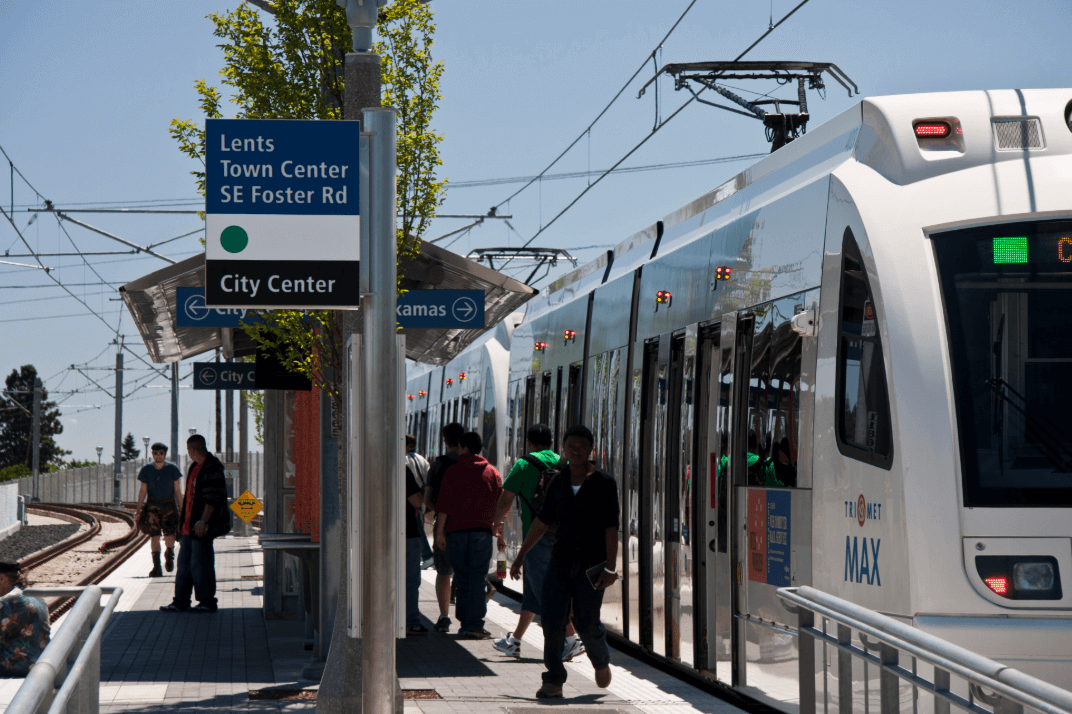
(photo from Wikipedia)
By Rachel Dawson 
TriMet has proven time and again that it is unable to live up to past promises. The MAX Green Line, which first opened 10 years ago, is no exception.
The Green Line is fifteen miles long and runs along I-205 from Portland State University to the Clackamas Town Center (CTC). It began as a portion of the North-South light rail alignment, which was canceled in 1988 after failing to secure voter funding. TriMet attempted to scale the alignment down to run from North Portland to the CTC, but the project was again rejected by voters in 1996 and 1998.
The plan for light rail to the CTC was later resurrected in 2001, and planning for the Green Line commenced in concert with the more recently implemented Orange Line to Milwaukie.
The alignment eventually earned federal approval in 2006. Of the total $575.7 million price tag, $478.2 million came from the federal government, $23 million came from the state, and $74.5 million came from local jurisdictions.
Of the local match, $69 million came from the City of Portland, $39.3 million from Clackamas County (the majority of which came from the county’s urban renewal funds), $23 million from the Oregon Department of Transportation, $20.5 million from TriMet, and $6.2 million from land donation and other funds.
The Green Line has failed to live up to these promised expectations:
Ridership is lower than projected. When the Federal Transit Administration completed its 2015 “Before and After Study” on the line, there was an average 24,000 daily weekday boarding rides. This is well below the 30,400 riders that TriMet predicted at entry into preliminary engineering for the line’s opening year. That number has continued to decrease to just over 16,000 average daily riders in August 2019, making up only 34% of the FEIS’s predicted ridership levels for 2025. With five years to go until 2025, it seems unlikely that the Green Line will garner the 30,500 riders needed to hit TriMet’s promised level of 46,500 boarding rides.
The line has lower frequency than promised. Trains arrive at stations every 15 minutes during peak periods and every 35 minutes at other times of the day. TriMet promised trains would arrive every 10 minutes during peak hours and every 15 during other times. TriMet attempted to blame this low level of service on a decline in tax revenues during the recession, but train frequency has not increased since the economy has recovered. Furthermore, TriMet’s total operating and non-operating revenues increased from 2009 to 2018 by 54%, and revenue from payroll and other taxes increased by 71%. The payroll tax rate will continue to go up every year until 2024, although it appears the Green Line’s level of service won’t increase with it.
Instead of the promised passengers, light rail brought increased crime to the CTC area. Clackamas County experienced heightened crime in the corridor from 2009-2012 after the Green Line opened and an increase in graffiti around MAX stops, according to a survey by the Oregon High Intensity Drug Trafficking Areas Program sent to the Clackamas County Sheriff.
Unsurprisingly, the line’s cost was higher than TriMet originally anticipated. The final price tag of $576 million was 14% greater than the anticipated cost in preliminary engineering, a difference of about $70 million.
TriMet is now planning for a 12-mile line from downtown Portland to Tigard. Elected officials from Tualatin, Tigard, Durham, and Washington County should take a sobering look at TriMet’s track record on the Green Line, the Yellow Line, and WES. It shows a consistent pattern of over-promising and under-performing. Given this history, TriMet’s projections for the SW Corridor project should not be trusted.
Rachel Dawson is a Policy Analyst at Cascade Policy Institute, Oregon’s free market public policy research organization.